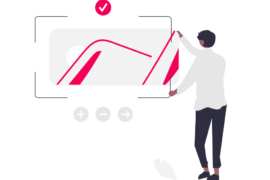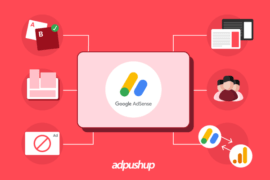Successfully running a website or a blog involves a lot of moving parts and getting the most out of your Adsense revenue is often an important part of the operation. Increasing your Adsense earnings is one thing, which probably is always on the mind of a webmaster. Ad revenue optimization makes it easier for you.
Optimize Ads, Regardless of Traffic
Of course, it’s no secret that many online publishers assume that this is simply a matter of increasing website traffic. While it’s true that this is definitely a part of the equation, it’s also true that many online publishers/webmasters are undermining the power of optimization (increasing CTR of your ad units) using ad and website testing. Ad revenue optimization can be used to improve Adsense revenue, even if traffic to the website in question doesn’t change at all. So, we will not focus on increasing traffic, on-page optimization, or improving traffic quality here, but on optimization with traffic remaining the same – same quality and the same quantity. The process involves making small changes to ensure that ads are performing to the best of their ability at all times.
There’s a lot that goes into optimizing Adsense ads, and for publishers looking to get their websites performing as best as they possibly can, there are a few core concepts that help out in a very big way. The best strategies, whether they’re implemented with Google Adsense or any other online ad network, will help make sure that ads are bringing in as much revenue as possible, regardless of any changes in traffic.
Your first Ad unit
Is your best-performing ad unit, in terms of CTR loading first? Yes, it does make a difference. See, when you have 2 or 3 ad units on your website (maximum units allowed by Adsense on a page are 3), the HTML structure should be such that the ad with the highest CTR (on average) should load first. This can be done using the <div> tags and a little CSS. The reason behind why it works is simple: Adsense fills the top paying ads first. So, the top-paying ad (first to load) might pay you 62 cents, the second one to load might pay you a little less, say 38 cents, and the last one: 25 cents. Now it does not take a genius to figure out that: Highest CTR on the Highest paying Ad unit = A lot of additional money, which you are probably not generating right now.

Location, Location, Location
Advertisements perform very differently based upon their location on a given page. Always make sure to place ads strategically as this makes it far easier to increase CTR (and your income) even when a site’s traffic stays constant. Placement is another concept that ties in directly with context and size. It is important to make sure that the placement of advertisements is executed strategically, and this is an instance where continuous testing and optimization is the key.
Responsive design is equally vital. Sites equipped with a responsive design will be able to feature ads that automatically adjust according to the size of the screen upon which they are being viewed. Ads that change automatically depending upon the viewer’s screensize are valuable when it comes time to increase your ad unit CTR and thereby your earnings. Not only does this help online content reach a wider audience by allowing it to be viewed on multiple devices, but it also decreases the loading time of a web page. Use this link to get sample codes for setting up responsive design ads on your website.
Size Definitely Matters
The size of the advertisements on a given web page has a very significant impact on how well those ads perform. For one thing, it’s generally agreed that wider ads have a tendency to perform better than taller ads do. Check this video from the Adsense Team. In a live example which they demonstrate, the replacement of 120×600 Skyscraper with a 160×600 Wide Skyscraper and replacement of a 468×60 Banner by a 300×250 Medium Rectangle, caused a 109% Increase in Adsense Revenues for that website. This is the power of optimization. Image how much time would it have taken the webmaster of this website to double his traffic, whereas these 2 small changes alone, doubled the adsense income. When it comes to something like ad size, it’s important to remember that context is key. This concept is hugely important when trying to increase Adsense income. Ads shouldn’t be so big that they overpower the actual content of any given website, but they shouldn’t be so small that they disappear beneath a sea of text and other images either.
Consider an ad’s placement on the page, and consider the page’s purpose when thinking about the ad’s size. Make sure that ads are complementary to the context that they’re featured alongside. It’s also important to test different ad sizes in different positions. This is an example of the “multi-armed bandit” problem in which there are many different possible combinations which might yield the best result, but another thing known about the web user behaviour is: constant change. The best performing variation today, is unlikely to be the same tomorrow, which is why we talk about A/B testing and continuous optimization next.
Keep in mind that ads should always be placed very thoughtfully, and in ways that complement the rest of the content featured on a given website. Relevance is always key, but size can have a serious effect on the way that an ad fits in with the rest of a website’s content. If an ad’s size and placement doesn’t mesh well, income will certainly be lost. Find the best size and placement combination by A/B testing various versions of advertisements to figure out which yields the best results.
Ad Design
Selecting Ad colors for the text ad units, which compliment your site, are important. I can’t stress enough on the importance of selecting the right ad colors on your Adsense text ad units. If you havn’t tried it, go ahead. Trust me, you’ll be surprised. Almost all sites I know of, which tried this, have benefited immensely. In fact, I ran an ad color test with 6 variations on a website, owned by a webmaster, whom I know from popular seo forum. This website witnessed a 75% increase in CTR for that ad unit, using one of these variations (in comparison to the control/original ad unit).

A/B Test everything
Location, Size & Design – All the 3 attributes of an ad unit must be tested to see which performs best. Pick a few different ad locations for each unit also called variations, split your traffic between the different variations (ensuring same variation is shown to the same visitor, every time) and compare the CTR from each of these variations. Similarly, pick different sizes for each ad unit and different ad colors for your text ad units. This testing can be done manually or you can use our tool to automate testing for you.
Test Constantly
The idea of “continuous optimization” is essential if online publishers wish to truly make the most out of their membership with Adsense or any other online ad network. The reason is simple, constant change is evident in a user’s behaviour and your best performing unit may not perform similarly, after a few months. With constant measurement, testing & machine learning, as soon as the performance of the unit starts to drops, the system re-identifies the best variation (of that time) and make it your default. This is one of the core philosophy behind our product – Adpushup and essentially what it does. To truly increase Adsense earnings, it’s important to make sure that the optimization process never stops.
When faced with such a complicated mathematical problem, constant testing is necessary so that publishers can always know where that “sweet spot” lies for Adsense ads. Subtle changes can have a huge impact on the way that ads perform, and a big part of marketing online involves staying up-to-date with the most current trends and practices.
Custom Search Bars are Your Friends
Google Adsense is perhaps the most popular online advertising network, and arguably the most preferred way to monetize a website. More clicks mean more revenue, but it is a mistake to assume that more traffic automatically means more clicks. Google allows publishers to place up to two Custom Search Bars on their pages. This allows for the implementation of relevant Adsense ads that will appear when visitors perform a search using the Custom Search Bar.
If a website performs well to begin with, a Custom Search Bar or two is a great way to optimize ad revenue without having to do anything in the way of increasing the website’s traffic. This type of action also shows the audience that their needs come first. A Custom Search Bar makes it very easy for a visitor to navigate through a publisher’s content, especially if there is a lot of it.
Utilize Calls to Action
If a website features a large, attractive call-to-action (CTA), it might be a good idea to place ads in close proximity to it. It’s important, however, to make sure that ads are designed in such a way that doesn’t confuse visitors due to its placement alongside an important CTA. Solutions to this problem include things like taking care to design ads that don’t appear too similar to an important call-to-action.
Content is King
How can content make an impact on the CTR of your ad units? Well, I don’t have enough stats yet to make a statement here, but I will be writing another post dedicated on the relation between quality of content and CTR. For now, Here are two examples, contrasting each other:
In an article by Jim Boykin. He says that if visitors find your “content sufficient, good and satisfactory”, they might not look further on your site and this will lead to a lower CTR. On the contrary, how about a very detailed and very well researched article (call it a masterpiece) telling you about a technology and after you’ve read the full 2000+ words about its pro and cons, right at the footer sits a very targeted ad, of a company selling a product with that technology, is it more likely that you (the visitor) will click on the ad now? Well, I leave it for you to decide on that, until I get some stats and write something on it.

Block Irrelevant Ads
Everybody knows that the more relevant and targeted the ads on your website are, the higher the CTR will be. So next time, when you see an irrelevant ad on your website, use your Adsense account to filter out such advertisers/domains.
Remember to Consider Other Ad Networks
Google Adsense, while one of the most popular and widely-used (also, generally highest paying) ad exchange network, is not the only one in existence. Simply put, some of them are better than others, and it’s up to online publishers to do their due diligence and make sure that they’re selecting the best ad network for their website and their revenue needs. What I mean to say is, Look outside the box. This could mean testing out a niche or vertical specific ad network. This could also mean trying CPA or Affliate networks. I’ve read a few threads on popular forums about webmasters making more money in commissions from clickbank and amazon, than Adsense. By looking at other options, online publishers can give themselves the chance to truly maximise their ad revenue.
When it comes to getting the most out of a website’s ad revenue, there are many ways to go about ensuring that an ad network membership is producing as much as it possibly can. Small changes can make a huge difference to the bottom line.
Finally, The Policies
No matter which SEO or Internet marketing forum I open, a common thread seen everywhere is webmasters writing about how google banning them from adsense. Nobody likes that. Make sure you read all the policies relating to ad placement, before you begin to make any changes.
Ankit is a co-founder @ AdPushup (a tool which helps online publishers optimize ad revenues) and loves online marketing & growth hacking.




